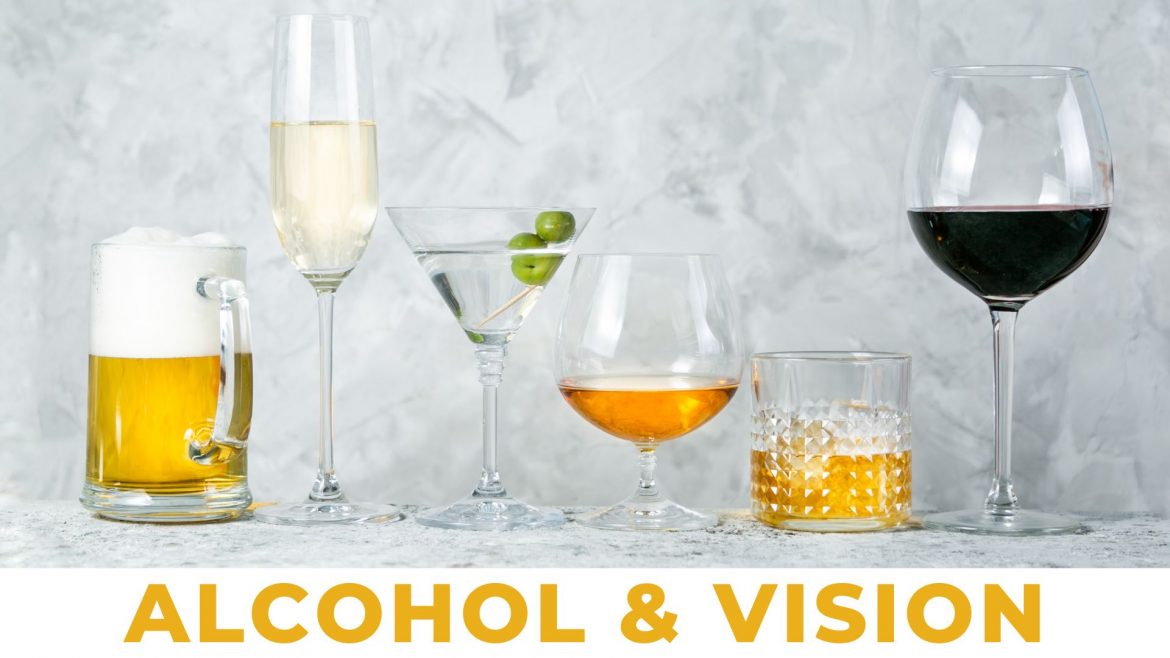
Although the negative health effects of drinking alcohol have been well established, nearly 65% of U.S. adults continue to consume alcoholic beverages on a regular basis. Considering there is a direct correlation between health issues and the amount of alcohol consumed, the issue becomes more concerning knowing that over 25% of U.S. adults report binge drinking (having six or more drinks in a sitting) in the last month.
One of the serious, but rarely discussed, alcohol-related health issues is the effect drinking has on vision and overall eye health. In fact, regular consumption of alcohol has been directly associated with a number of serious short and long-term vision issues that range from blurred vision to damage to the optic nerve resulting in permanent vision loss.
How alcohol affects short-term vision health
Alcohol is classified as a depressant, meaning it slows basic brain functions associated with speech, movement, judgment, reaction time, and vision. While the immediate, short-term effects of alcohol on the brain typically last only as long as it takes for your body to metabolize it, these effects can include:
Blurred vision
Alcohol slows the brain’s ability to send important messages to muscles throughout the body. Since your eyes are made up of muscles, they are also affected by this delayed messaging and often do not respond to stimuli normally. When this happens, it’s very common to experience blurred vision, and in some cases, double vision.
Tunnel vision
In addition to slowing the communication between the brain and the eyes, alcohol also decreases peripheral vision, or the ability to see out of the “corners” of your eyes. This narrowing of your field of vision, more commonly known as tunnel vision, is just one of the reasons why driving under the influence of alcohol is so dangerous.
Migraine headaches
Migraines are severe and debilitating headaches characterized by nausea, dizziness, sensitivity to light, distorted vision, and seeing halos or flashes of light. Recent research has demonstrated alcohol, even in small quantities, has the potential to trigger migraines severe enough to disrupt vision. Interestingly, while alcohol has been shown to trigger migraines, doctors have not yet been able to determine exactly why this happens.
Other short-term eye health issues that have been associated with drinking alcohol include dry and or bloodshot eyes, sensitivity to light, and twitching of the eyelids, a condition known as myokymia.
Understanding the long-term eye health effects of alcohol
While short-term health effects, including double or blurred vision, typically go away when alcohol isn’t being consumed, these conditions do have the potential to become chronic issues. Over time, repeated abuse of alcohol can lead to permanent damage to the brain and neurotransmitters that are specifically related to vision. Repeated and prolonged use of alcohol can also cause the eyes and eye-related muscles to weaken. This can lead to serious issues, including loss of coordination between the eyes, a slowing of the iris’ ability to contract, and chronic myokymia.
Other serious, long-term vision problems resulting from drinking alcohol include early-onset cataracts, age-related macular degeneration, and optic neuropathy.
Early onset cataracts
In normal, everyday situations, cataracts typically begin to develop after age 55. However, recent research has shown heavy drinking significantly contributes to the development of cataracts and increases the risk of experiencing the condition much earlier than age 55.
Age-related macular degeneration
Age-related macular degeneration, or AMD, is a progressive eye health condition that causes permanent and irreversible damage to your central vision. Characterized by a progressive blurriness that makes it increasingly difficult to see fine details, AMD is caused by the gradual degeneration and thinning of the macula, the part of the retina responsible for ensuring sharp, central vision.
Interestingly, recent research has identified certain lifestyle choices—and specifically, alcohol consumption—as significant contributors to early AMD, especially when compared to causal and non-drinkers.
Optic neuropathy
Perhaps the most serious, and most common, long-term eye health condition associated with alcohol consumption is optic neuropathy. Most frequently associated with excessive alcohol or tobacco use, the condition causes optic atrophy resulting in peripheral vision loss, loss of color vision, the appearance of flashing lights within the line of sight, and dull pain during normal eye movement.
Specifically, and over time, alcohol use weakens the eye muscles and contributes to permanent optic nerve damage. The optic nerve is responsible for communication interactions between the brain and the eye.
In addition to weakening the muscles and damaging the optic nerve, frequent alcohol use contributes to inflammation within the bundle of nerves that make up the optic nerve. This constant swelling and inflammation often results in double vision and blurred eyesight and contributes to vision loss.
How much is too much?
As doctors continue to study exactly how alcohol affects vision and eye health, one thing their research has demonstrated is eye health is directly affected by the amount of alcohol you consume. In other words, while an occasional glass of wine won’t cause significant long-term damage to your health, regularly drinking too much alcohol will.
Recent research published in the American Journal of Ophthalmology suggests that having three or more alcoholic drinks a day significantly increases the long-term risk of developing serious eye health issues, especially age-related macular degeneration and optic neuropathy.
Considering this information, and the clear correlation between overall health, vision, and alcohol consumption, the Center for Disease Control recommends limiting alcohol intake to less than two drinks per day for men and less than one drink per day for women.

